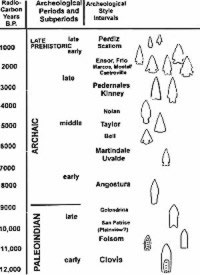
Key archeological markers at Kincaid
Shelter. Artifacts from the site represent cultures
spanning more than 13,000 years and include most of
the Central Texas archeological periods and subperiods
used by archeologists to frame and interpret site occupations.
Graphic adapted from Collins 1995 and Prewitt 1981 as
shown in Turner and Hester's 1993 Stone Tools of Texas
Indians.
|

This mandible, or lower jaw, of extinct
horse was found in Zone 2. The presence of three deciduous,
"baby" teeth indicates the animal was a juvenile. Additional
fossil horse bones were found in Zones 3 and 4. Photo
by Susan Dial.
|
| The remains of alligator
and aquatic turtles in Zones 3 and 4 indicate the Sabinal
was a more constantly flowing river during the Late Pleistocene
period. |
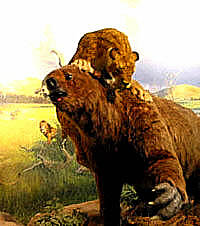
A lion attacks a giant ground sloth
in this Late Pleistocene scene recreated at the La Brea
Museum in California. Bones of both sloth and lion were
found in Zone 3 at Kincaid Shelter, suggesting that
similar scenes were played out in ancient times in the
Texas Hill Country.
|
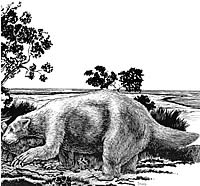
The North American ground sloth,
or Mylodon. Drawing by Hal Story.
|
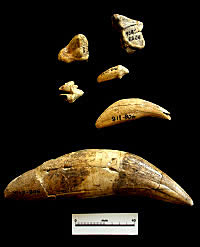
Teeth of the carnivores found at
Kincaid include a massive canine from the great cave
lion (Panthera atrox), shown at bottom, and dire wolf.
Photo by Susan Dial.
|
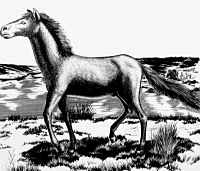
The Late Pleistocene horse, Equus
sp., was by far the most abundant species in Zone 3,
and is represented by more than 50 teeth, several jaws,
and a few fragmentary limb bones. The extinct species
was roughly the same size as the modern horse, which
was introduced to North America by Spanish explorers
in the 1500s. Drawing by Hal Story. Click to see full
image.
|
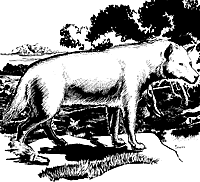
The dire wolf. Bones of this Late Pleistocene carnivore were found in Zone 3. Drawing by Hal Story.
|
|
Investigators faced a complicated problem in
interpreting the deep deposits of sediment representing thousands
of years of natural deposition and human activities in Kincaid
Shelter. More than 10 feet (3 m) in depth, the excavated deposits
spanned Late Pleistocene to recent times and represented different
types of sediment accumulation, ranging from wind-blown dust
and floodwater silt to ash, charcoal and rocks from campfires.
In the deeper, older zones, the excavators encountered
layers of pond clay and spring-deposited travertine—reminders
of the wet conditions in the cave which prompted early inhabitants
to construct a rock pavement over the muddy floor. The spring,
which emanated at the back of the shelter, apparently ceased
to run after early Paleoindian times (after the deposition
of Zone 4).
Within the deposits investigators found animal
bones from both extinct and modern species and a variety of
items left behind by countless generations of human occupants
at the shelter. Among the artifacts were projectile points
and other diagnostic stone tools representing almost all intervals
of the Central Texas archeological sequence.
There was not, however, a clear stratigraphic
ordering of diagnostic types, the time-sensitive artifacts
that could be compared to those recovered from other, better
dated sites. Erosion and human disturbances (both ancient
and more recent) had disrupted the Kincaid deposits, mixing
together many of the artifacts. More than half the artifacts
recovered from Kincaid were found in the treasure-hunters'
backdirt piles.
Several hearths (warming or cooking features)
also were found in Zones 5 and 6, but these were not fully
documented. Although there were no burials found within the
shelter, investigators recovered some 60 human bones scattered
within the two upper zones, representing at least four individuals.
These skeletal remains were probably from burials that were
disturbed by animals or later occupants of the shelter.
The walls of the deep trench in the center of
the shelter provided a stratigraphic "profile" that
helped geologists Glen Evans and E. H. Sellards classify the
deposits into the various zones (stratigraphic units). These
are described below, beginning with the oldest unit, Zone
1, and include a detailed look at the rock pavement constructed
over Zone 3.
Early Non-Cultural Zones
Zone 1. Zone 1 is the lowermost unit
of the shelter fill encountered during the excavations. The
full thickness of this zone was penetrated only in the back
and west parts of the shelter, where it was thinned out against
the sloping limestone walls. One excavation square at the
front edge of the shelter was dug to a depth of 14 feet (4.2
m) below the surface and penetrated 5 feet, 7 inches (1.7
m) into Zone 1 without reaching bedrock.
Zone 1 consisted of a buff-colored, floodplain
silt with a few stringers (thin layers) of small, rounded
limestone pebbles. Numerous spalls and blocks of limestone
from the shelter walls and ceiling occurred at the base and
back margin of the zone. No cultural materials or fossil animal
bones were found in Zone 1.
Zone 2. This zone was a silty,
river-laid deposit up to nearly 4 feet (1.2 m) in thickness.
It was entirely truncated (cut out) by water erosion immediately
in front of the shelter. No cultural materials were found
in Zone 2, but one identifiable fossil, a partial jaw with
three teeth, belonging to an extinct species of horse, Equus
sp., was found in the middle part of the deposit. This
zone can be assigned to the Wisconsin stage of the Pleistocene.
(The Wisconsin stage was the last major glaciation period
in North America, roughly 75,000 to 12,000 years ago.)
A Late-Pleistocene Menagerie
Zone 3. During the time represented in
Zone 3, a small, spring-fed pond filled a low area in the
center of the shelter. The bones of many types of animals—perhaps
the dinner leavings of a large carnivore such as a cave lion—began
to accumulate nearby. There is some, albeit scant, evidence
of human occupation of the shelter during this time.
Zone 3 consisted of a ponded clay deposit containing
layers of clay and fine silty clay resulting from deposition
in the placid pond with intermittent episodes of flooding.
The clay deposit reached a maximum thickness of 1.5 feet (46
cm) thick and occupied a shallow central depression apparently
formed by high flood waters of the Sabinal River washing into
the shelter. A travertine deposit (calcareous limestone formed
by mineral-laden water) in the back wall extended into the
clay. This deposit indicates that the pond was fed by seep
springs. In the front part of the shelter, the clay deposit
(Zone 3), as well as Zone 2, had been completely removed by
erosion.
Except in the front eroded area, Zone 3 was
capped by an ancient, man-made rock pavement which lay between
Zones 3 and 4. Additional small patches of cobblestone pavement
covering an estimated total area of 30 to 40 square feet (2.8
to 3.7 square meters) occurred in the middle portion of the
zone, and were overlain by stream-deposited seams of silt
and clay, which in turn, were overlain by the larger rock
pavement. These intra-zonal patches of pavement will be further
discussed below in a separate section dealing with the rock
floor pavement.
Fossil bones and teeth representing several
extinct vertebrate species occurred in Zone 3, including horse,
mammoth, large cat, ground sloth, camel, bison, wolf, antelope,
raccoon, alligator, and two genera of aquatic turtles. Although
most of the bones were badly broken and decomposed, a number
of teeth, along with some jaws and other hard skeletal parts,
were found in good condition. The advanced stage of decomposition
seen in most of the bones suggests that they were exposed
at the surface for a considerable period of time before being
buried by the sediment. Quite possibly the bones were broken
by man or by carnivorous animals. The most important elements
that have been recognized from the fauna of Zone 3 are listed
below.
The extinct great American lion (also known
as cave lion), Panthera atrox, is represented by a
canine tooth. Some badly decomposed foot bones of another
species of Panthera, possibly P. onca, the jaguar,
also were found imbedded in the clay of Zone 3, A ground sloth,
Paramylodon, is represented by a broken tooth, jaw
fragment, and part of one vertebra. Camel, Camelops sp.,
is represented by a jaw with cheek teeth of an immature individual,
and by several other broken bones and teeth. Other mammals,
represented by teeth and identifiable limb bones, include
bison, a large wolf, antelope, and raccoon.
Alligator is represented by a series of articulated
vertebrae and some scutes and broken limb bones. Bones of
two genera of aquatic turtles, identified as Trionyx sp.
and Pseudemys sp., also were found in Zone 3. The presence
of alligator and aquatic turtles indicates a source of permanent
water in the near vicinity, the ancient Sabinal River.
Several small patches of cobblestone pavement
apparently were found at a level below the main rock floor
pavement, and Evans thought these might be evidence of human
activity in Zone 3. Three thin flint flakes and a fourth thicker
flake with a chipped edge also were found in this zone, but
these items likely were introduced into Zone 3 during the
construction of the main rock pavement.
Evans also considered the numerous animal bones
in Zone 3 as possible evidence of human hunters. Vertebrate
paleontologist Melissa Winans, who analyzed the Kincaid fauna,
thought a more likely explanation was that animal predators
denned in the shelter were responsible for the bone accumulation.
None of the bones bear either identifiable butchering marks
or carnivore tooth marks; however, most of the bones have
undergone extensive weathering which could have erased any
identifying marks that may originally have been present.
The Rock Pavement
|
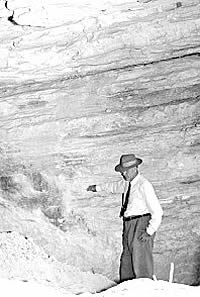
Geologist E. H. Sellards, director
of the Texas Memorial Museum, shown at the mouth of
the shelter. Photo by Glen Evans, 1948.
Click images to enlarge
|
|
What is the Pleistocene?
Known also as the "Great Ice Age," the
Pleistocene is the geologic term for an epoch of the
Quaternary period stretching from about 1.8 million
to 12,000 years ago. The word "Pleistocene"
derives from the Greek words "pleistos," meaning
most, and "ceno," new. The first humans entered
North America at the end of the Late Pleistocene when
megafauna such as mammoth, cave lion, ground sloth,
dire wolf, and giant bison still roamed the continent.
|
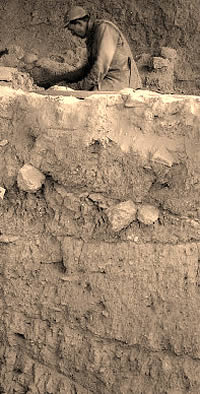
TMM crew member Powell Goodwin exposes
the rock pavement at the base of Zone 4. Below him,
layers of deposits which have been outlined with a sharp
tool to make them more visible, can be seen in the trench
wall, foreground. Photo by Glen Evans.
|
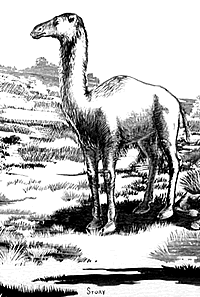
Camels roamed the Edwards Plateau
during Late Pleistocene times. Remains of the extinct
species Camelops were found in Zone 3. The animal may
have been dinner for a large carnivore, such as lion
or dire wolf, denning in the shelter. Drawing by Hal
Story.
|
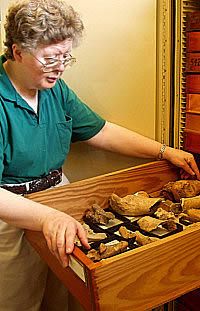
University of Texas vertebrate paleontologist
Melissa Winans looks over a drawer of the Kincaid faunal
materials that she analyzed in the late 1970s. The drawer
she is holding is filled with the remains of large fauna,
including bison and camel. Photo by Susan Dial.
|
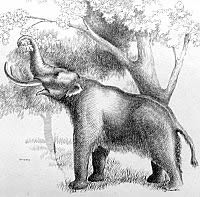
A mammoth browses tree leaves in
this drawing by Hal Story. Fragments of bone, teeth,
and tusk were found in Zone 3, and one partial elephant
rib was found crushed between large boulders of the
man-made rock pavement on the upper surface of the clay.
It is not known whether the predators were human or
carnivorous animals. Drawing by Hal Story.
|
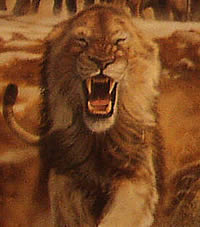
An American lion, as interpreted
by artist George Teichmann. The Late Pleistocene creatures
were larger than the modern African lion, standing almost
5 feet tall at the shoulder. They were prevalent throughout
Asia and North America before their extinction. Detail
of painting by George Teichman, courtesy of the artist
and the Yukon Beringia Centre. Click to see full image
of Ice Age creatures in the Yukon.
|
|